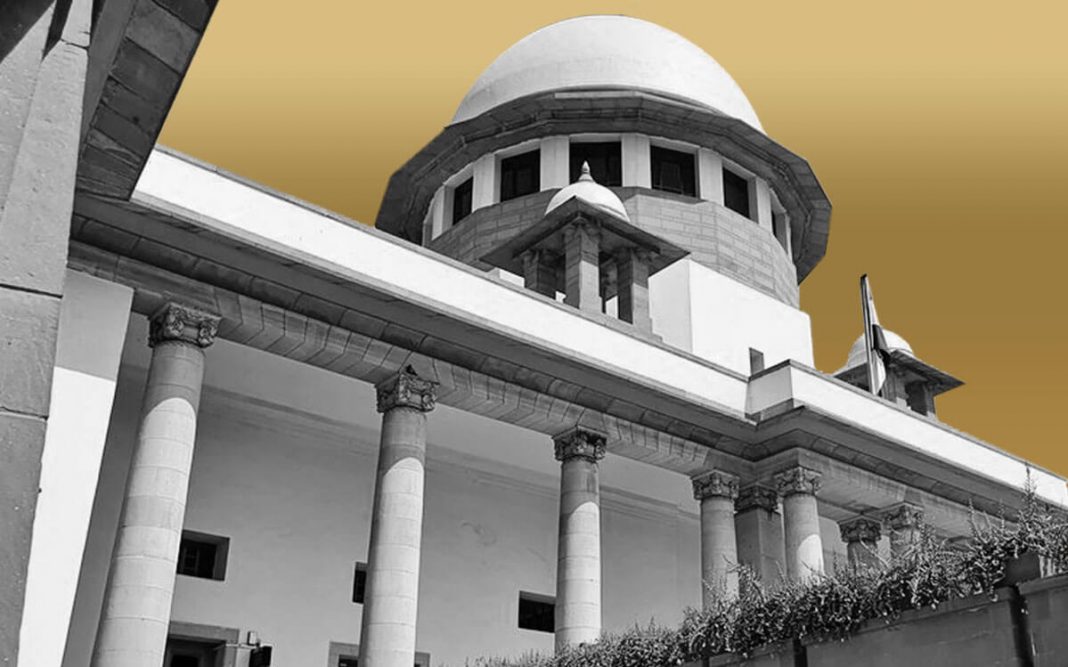The State of Uttar Pradesh on Friday informed the Supreme Court that it has withdrawn 274 notices issued to Anti-CAA protestors in 2019 for recovery of damages done to public property and proceedings initiated against them, during protests against the Citizenship Amendment Act and the proposed NRC.
The matter was listed before the Bench of Justice D.Y. Chandrachud and Justice Surya Kant. The Court granted liberty to the UP government to proceed against alleged anti-CAA protestors under the new law “Uttar Pradesh Recovery of Damages to Public and Private Property Act” notified on August 31, 2020.
Nilofar khan/Petitioner, asked the bench to pass direction to the state govt to refund back the money to small vendors, whose properties were either vandalized or seized by authorities. AAG Garima Prasad prayed the bench to pass the order of status quo in concerned to release the money back to vendors.
To which, Bench refused to pass any order of status quo with regard to recovery of money from state government to vendors.
The Supreme Court was hearing a plea filed by one Parwaiz Arif Titu seeking quashing of notices sent to alleged protestors by the district administration for recovering losses caused by damage to public properties during the anti-Citizenship (Amendment) Act (CAA) agitations in Uttar Pradesh and asked the state to respond to it. The plea has alleged that such notices have been sent arbitrarily against a person, who had died six years ago at the age at the age of 94 and also to several others including two people who are aged above 90.
On 11th February, the Supreme Court had given a final opportunity to the Uttar Pradesh government to withdraw the proceedings against the alleged anti-CAA protestors of the December 2019 incident saying that it was in complete violation of the law laid down by it.
Also Read: Calcutta High Court dismisses PIL seeking Governor Dhankhar’s removal
The Court had said that if the government fails to withdraw it, the court will quash the proceedings. The court said that the UP government had appointed ADMs to oversee the claim tribunals instead of judicial officers. The court had delivered two judgments in 2009 and 2018 related to it. The court had said that the proceedings were contrary to the law laid down by the Supreme Court and cannot be sustained.
Formation of Committee and guidelines by Supreme Court :
The Supreme Court took note of instances of mass violence and damage that it caused to public property across the country in 2007. The Court gave directions for formation of two Committees under former Judge K.T. Thomas and Senior Advocate Fali S. Nariman to recommend legal steps to handle the situation.
In a judgement passed in 2009 titled as Re: Destruction of Public and Private Properties vs Govt. Of A.P. the Supreme Court issued guidelines based on recommendations of these committees, and allowed the High Court to take cognizance of incidents of mass damages to public property in absence of a state legislation.
These guidelines were re-appreciated and re-affirmed in Supreme Court in 2018 in another judgement titled as Kodungallur Film Society & Anr. vs Union of India and Ors. The guidelines laid down were as follows:
The guidelines will be applicable only in cases of absence of legislation in this regard
In cases of mass destruction to property , the High Court may take suo motu action and set up a machinery to investigate the damage caused and award compensation. The Court can take suo motu action or the State Government may file a petition before the High Court.
Also Read: Centre appoints 5 debt recovery appellate tribunal chairpersons after Supreme Court ire
A sitting or retired High Court or District Court judge as a Claims Commissioner to estimate the damages and the liability.
A report has to be given by the Claims Commissioner to the High Court or Supreme Court, following which the Court will decide the liability after hearing the parties.
Contradiction between the Guidelines given by Supreme Court and Allahabad High Court
The Supreme Court puts the Onus of assessment of damages and recovery from the accused on High Courts of every State, whereas the High Court puts it on the State Government, making them responsible for undertaking processes to recover damages.
The High Court guidelines take away the aspect of Judicial overview, removing a safety mechanism against arbitrary action, while in the Supreme Court guidelines, the High Court is supposed to give people an opportunity of being heard.
Reason for the petitioner moving before Hon’ble Supreme Court :
The petitioner has clearly stated the reason for moving the petition before the Supreme Court, as a Public Interest Litigation and not before the High court of Uttar Pradesh, in his petition before the Supreme Court. The reason stated is the situation of total anarchy in the state of Uttar Pradesh where people are afraid of their lives and property, and a possibility of not being spared by the state government. According to the petitioner, the Chief Minister of the state has been against the protestors from the very beginning, even before the demonstrations had begun he had declared that there was no reason for a protest against CAA, and many congratulatory tweets were posted by his office against the protestors.
The way in which the Government, administration, and police acted against the protests by using disproportionate force and denied public accountability, was completely against the basic principles of democracy, violation of principles of Rule of Law and complete violation of Fundamental Rights guaranteed under Articles 14, 19, 20 and 21 of the Constitution of India.


